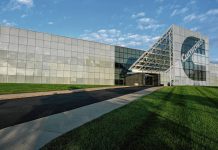The instant gratification of the Mill Race Marathon is easy to see, with smiles, cheers and medals rewarding personal accomplishments.
What may be less noticeable, but has equal importance, is the lasting impact that money raised by the event has had on the Columbus community’s health and wellness.
Since its beginning in 2013, the Mill Race Marathon has brought in and donated $295,000 to two local organizations: the Healthy Communities initiative and the Columbus Park Foundation. In the hands of these caretakers, the funds have been used to grow community health and wellness initiatives.
“Mill Race Marathon has a common synergy with Healthy Communities and the Park Foundation in creating an event that provides something for all ages,” said Laura Chasse, Mill Race Marathon Planning Committee member. “Donations from the first four years have provided continued benefit and support to the community.”
[sc:text-divider text-divider-title=”Story continues below gallery” ]
In both 2013 and 2014, each organization received $40,000. A total of $50,000 was divided among them in 2015. And last year, donations increased to $85,000, again split between Healthy Communities and the Park Foundation, although more went to Healthy Communities.
The main projects that have benefited from these donations include the city’s bike-sharing program, expansion of the People Trails and increasing the amount of locally grown nutritious food availability for residents.
Food focused
Healthy Communities used its money to hire a consultant in 2013 to conduct a local food study for Bartholomew and Jackson counties, said Beth Morris, director of community health partnerships at Columbus Regional Health.
The study had some interesting results, including that more than 90 percent of Indiana’s food is imported, Morris said.
“If every household in Bartholomew County would spend $5 a week more on locally produced food, it would mean an additional $32 million that stays in our home county,” Morris said previously.
In 2014, Healthy Communities focused its allotment toward starting or expanding school gardens at Columbus East, Columbus Signature Academy – New Tech High School, Parkside Elementary and Hauser Jr./Sr. High.
New Tech received some additional funding the next year — still from the 2014 donations — to install a rainwater-reliant irrigation system to its garden, Morris said.
With the addition of this garden and drip irrigation system, students have learned more than just how to grow food, said Andrew Larson, CSA – New Tech science teacher. They have also learned about sustainability, engineering and community access to fresh food.
Students are involved in every process to improve the system and increase food production, Larson said, and were involved in designing and building a shed, also funded through Healthy Communities.
“It’s truly been wonderful to see the program grow,” Larson said. “And we could not do it without the infusion of funds from groups like Healthy Communities.”
Some funds are still available from the 2014 allocation earmarked for school gardens, Morris said.
“School gardens are an amazing way for students to learn lessons in earth science, life science, math and nutrition,” Morris said.
Some schools have used produce from the school gardens to serve in their cafeterias.
Trail building
The Columbus Park Foundation put its 2013 donation toward the People Trail expansion fund for the Lincoln Park extension over Haw Creek.
“The money has gone into our People Trail Campaign and will continue to grow our People Trails, which are very important not only for recreation, but for transportation,” said Mark Jones, director of the Columbus Parks and Recreation Department.
The foundation has noticed a trend in recent years of more people using the trails as a means to get from one place to another instead of just as a recreational trail, Jones said.
In 2014, the foundation split its funds — one half to the People Trail expansion fund and the other to purchasing pedestrian barriers, said Randy Stafford, a member of the Mill Race Marathon Planning Committee.
These barriers were then donated to the Columbus Parks and Recreation Department to use for city sponsored events, Jones said.
Bike sharing
In 2015, when $50,000 was split evenly between the two organizations, it all ended up in the same place: ColumBIKE, Columbus’ bike-sharing program.
Healthy Communities donated its half to the Park Foundation to use in the program, Morris said.
ColumBIKE launched its eight bike-rental stations — most of them downtown — last year on on May 21 and saw nearly all of its 78-bicycle inventory used over the program’s first seven months. The fleet now has 79 Bcycle units.
The program has helped to increase physical exercise and convenience, ColumBIKE users said, especially downtown where Cummins Inc. and other businesses are bustling during the workweek.
Dan Novreske, a Cummins engineer and annual member of the bike-sharing program, likes that ColumBIKE has made it simple to complete a quick errand or get to a nearby Cummins building without having to get in his car.
“The trips by bike take about the same amount of time as a car, plus I get exercise,” Novreske said.
“(ColumBIKE’s) presence can do nothing but benefit anyone who decides to give it a try,” said Grant Hale, an annual ColumBIKE member and stay-at-home dad.
Without the donations from the marathon, ColumBIKE would probably not be in operation today, Jones said. Instead, the park foundation would likely still be seeking funds, he said.
“The (Mill Race Marathon) is such a wonderful community event and how they give back to the community is very special,” Jones said. “Mill Race Marathon has been a very important part (of ColumBIKE), as have our other sponsors.”
Latest funding
Last year, the total amount of proceeds increased to $85,000, with Healthy Communities receiving $50,000 and the Columbus Park Foundation receiving $35,000, Stafford said.
The Park Foundation has earmarked its money for new signage for the People Trails, although those signs won’t be seen for a while.
Currently, the Park Foundation is working with the city to update the Bike and Pedestrian Master Plan, which will include signage, Jones said. The Park Foundation is working closely with the city to ensure everything is done the right way, he said.
Most of the allotted money to Healthy Communities went toward “double bucks” at the Columbus and Seymour farmers markets.
Double bucks are available to recipients of SNAP, the Supplemental Nutrition Assistance Program, also known as food stamps, Morris said. Double bucks allows users to get tokens to be used at the markets to purchase produce, eggs or meat from specific vendors. However, these tokens cannot be used for prepared food or non-food items.
“This program gives SNAP recipients the opportunity to increase the fresh fruits and vegetables in their households and it’s been very enthusiastically received,” Morris said.
Also, $10,000 of Healthy Communities’ 2016 funds went toward Foundation For Youth’s Girls on the Run program, Morris said.
The rest of Healthy Communities’ money will be used to buy at least one health food-stocked vending machine for Bartholomew Consolidated School Corp. The school district is still deciding on what machine to buy, however, so it’s not clear yet whether there are enough funds to purchase more than one, Morris said.
Looking ahead
Although project proposals for 2017 are not yet finalized, the Mill Race Marathon Planning Committee is expecting to have a minimum of $80,000 available to distribute again this year, Stafford said.
The committee intends to continue collaborating with both Healthy Communities and the Park Foundation, Chasse said.
“Our goal is to help people make a positive change in their life,” Chasse said.
One local resident said that is appreciated.
“It’s nice to live somewhere like Columbus where people actually care about not only their own health, but the health of the entire community,” Hale said. “That’s something special we have here and we should celebrate it.”
[sc:pullout-title pullout-title=”At a glance” ][sc:pullout-text-begin]
A year-by-year look at how the money raised by the Mill Race Marathon was donated to the two designated recipients: the Healthy Communities initiative and the Columbus Park Foundation.
2013
Healthy Communities: $40,000
Columbus Park Foundation: $40,000
2014
Healthy Communities: $40,000
Columbus Park Foundation: $40,000
2015
Healthy Communities: $25,000
Columbus Park Foundation: $25,000
2016
Healthy Communities: $50,000
Columbus Park Foundation: $35,000
[sc:pullout-text-end][sc:pullout-title pullout-title=”About the marathon” ][sc:pullout-text-begin]
What: Mill Race Marathon, a fifth annual running event in Columbus that features a marathon, half-marathon and 5K run/walk.
When: 7:30 a.m. Sept. 23.
Where: Downtown Columbus and other parts of the city.
Notable: The Mill Race Marathon is a qualifier for the Boston Marathon.
Kids Fun Run: 6 p.m. Sept. 22 at Mill Race Park.
Health and Wellness Expo, packet pickup: 10 a.m. to 8 p.m. Sept. 22 at The Commons, 300 Washington St.
[sc:pullout-text-end][sc:pullout-title pullout-title=”Share your questions, experiences” ][sc:pullout-text-begin]
Thinking about entering the Mill Race Marathon for the first time? What do you want to know to help make that first time a great experience?
Or if you’ve run before, we want to hear about your personal experiences — and share them with other runners.
Although the race is four months away, we’ll begin a weekly page devoted to marathon preparation just weeks from now.
Send your marathon-related questions and stories ideas by email to [email protected]. Include your name, contact information (phone numbers, email) and a brief description of your personal running history.
[sc:pullout-text-end][sc:pullout-title pullout-title=”How to register” ][sc:pullout-text-begin]
Here is how to register for the fifth annual Mill Race Marathon:
Go online to millracemarathon.com
Click the “register” tab toward the top of the page
Follow the instructions for online registration, or download an entry in PDF form and mail it
Registration fees through June 30 are $65 for the marathon, $50 for the half-marathon and $20 for the 5K. Entry fees increase three more times after that date.
[sc:pullout-text-end]




